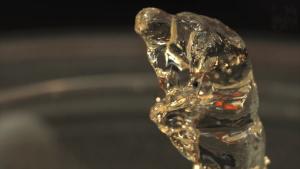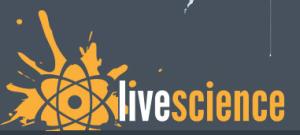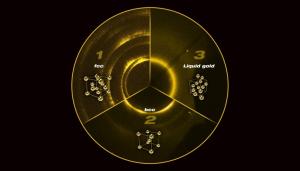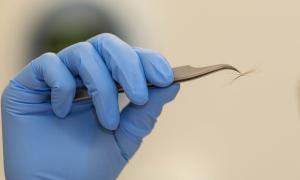LAB REPORT
Science and Technology Making Headlines
Aug. 9, 2019


People cooled off in in the fountains of the Trocadero gardens in Paris last month, when a new all-time high temperature of 108.7 degrees Fahrenheit hit the French capital. AP Photo/Rafael Yaghobzadeh
It’s getting hot out here
The heat wave that smashed temperature records in Western Europe last month was made more likely and intensified by man-made climate change, according to a recent study.
The rapid study by a respected team of European scientists should be a warning of things to come, the report’s lead author said.
A climate expert not connected to the study, Celine Bonfils of the Lawrence Livermore National Laboratory, said the findings are clear: “record hot weather events are becoming more likely, and human-induced climate change is causing this increase in heat wave frequency.”
The new report agreed with that assessment, saying that every recent European heat wave that has been analyzed “was found to be made much more likely and more intense due to human-induced climate change.”


By using different agricultural practices such as no-till farming, the soil can store more carbon that it would by tilling the land. Image courtesy of Jason Johnson/ National Resources Conservation Service
A different kind of farming
The battle against climate change has focused on reducing emissions. An “ideal plant” could join the war from the other end — by guzzling more carbon dioxide.
The ideal plant concept is just one of a number of carbon dioxide removal projects being pursued around the world — from huge machines that pull CO2 out of the air to power plants that inject carbon underground. But some environmentalists believe these technologies will never work as hoped, and that focusing on them creates a dangerous illusion that polluters can keep polluting.
There are three ways to pull carbon dioxide from the air. One is to boost Earth’s natural carbon sinks, such as planting more forests or restoring seagrass beds. Nature-based methods for CO2 removal also include sequestering carbon in soils, as with the ideal plant or by using different agricultural practices such as no-till farming, which can help soils store more carbon.
“We are very interested in soil carbons because over the course of recent human history, we have lost the equivalent of 450 billion tons of carbon dioxide from agricultural soils,” says Roger Aines, head of negative emissions research at Lawrence Livermore National Laboratory.
Restoring this lost carbon can make agricultural soils more productive, Aines points out. According to a recent study in the journal Nature Sustainability, the top two meters of the Earth’s soil already store more than three times as much carbon as the atmosphere and have the potential to store even more.


Computed Axial Lithography is a new method for producing 3D parts that uses light, projectors and resin to create objects like this model of Rodin’s sculpture “The Thinker.”
Business is booming
The Sandia and Lawrence Livermore national labs have been at the core of the Tri-Valley’s innovation economy long before the area began to experience the explosive growth that has come to define the region. According to the staff at both labs, the innovations never really stop coming.
Patrick Dempsey of Lawrence Livermore National Lab says that there’s a great deal of activity at the lab. A new advanced manufacturing laboratory is nearly complete, allowing for “developing partnerships with either current partners or partners we have yet to identify who could help us develop our technology,” he said.
A few of the LLNL innovations include: A new 3D printing device capable of making complex parts in a single piece, which helps improve additive manufacturing in terms of both speed and effectiveness; and organ-on-a-chip research that would reduce the need for animal testing.
The advancement of the labs also can be attributed to the Livermore Valley Open Campus (LVOC), an outreach program designed to enhance partnerships with the private sector in the Tri-Valley community.


To figure out the structure of gold at extreme conditions, LLNL researchers hit the gold with X-rays and detected where they bounced off (the signals for the different structures can be seen in this image).
Eureka: a new form of gold
Under extreme conditions, gold rearranges its atoms and forms a previously unknown structure. And when the pressures were pushed to the equivalent of those at the center of the Earth, the gold got even weirder.
The finding comes from a new study in which researchers from Lawrence Livermore National Laboratory and the Carnegie Institution for Science practiced their 21st-century alchemy at the Argonne National Laboratory. Using a high-energy laser, they heated gold to extreme temperatures and compressed it to pressures as high as those found at the center of the Earth.
More specifically, they put a little piece of plastic in front of a chunk of gold and then shot a high-energy laser through the plastic, which "basically causes an explosion that sends plastic one way and shock waves in the opposite direction," said lead author Richard Briggs, a postdoctoral scientist at LLNL.
Those shock waves hit the gold and caused it to compress and heat up extremely quickly, within nanoseconds. They then hit the gold with X-rays and detected where the X-rays bounced off in order to figure out its structure.


An LLNL team found that a single hair from anywhere on the human body can be used to identify a person.
As unique as a fingerprint
Lawrence Livermore scientists have found that pubic hair has some serious crime-busting potential — perhaps even more so than hair from other parts of the body – when it comes to identifying a sexual assault suspect.
Hair can be invaluable in a forensic investigation, but pubic hair, interestingly, is an entirely different ballgame. In their analysis, a team of LLNL of scientists show that pubic hair is far more complex than arm or even head hair, displaying more individual-specific markers that could help identify potential suspects.
With just a single strand of pubic hair, says Deon Anex, a chemist at LLNL, scientists can make a dent in a particularly prescient problem in the United States: sexual assault cases.
“Pubic hair is often collected as evidence of a sexual assault. In many cases, DNA evidence is collected as a fluid that can compromise multiple contributors. These mixtures can be hard to deconvolute to identify one particular contributor,” he said. “Clearly a single hair comes from a single contributor and can be used to aid in a positive identification.”
With further testing, the team suggests that a single strand of pubic hair could potentially identify someone in a population of 10 million.





